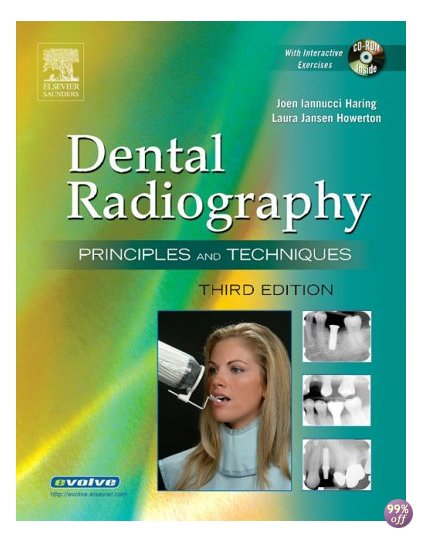Test Bank for Dental Radiography Principles and Techniques 4th Edition by Haring
$35.00 Original price was: $35.00.$26.50Current price is: $26.50.
Test Bank for Dental Radiography Principles and Techniques 4th Edition by Haring
Instant download Test Bank for Dental Radiography Principles and Techniques 4th Edition by Haring pdf docx epub after payment.
Iannucci: Dental Radiography, 4th Edition
Chapter 01: Radiation History
Test Bank
MULTIPLE CHOICE
- Radiation is defined as:
| A. | A form of energy carried by waves or streams of particles. |
| B. | A beam of energy that has the power to penetrate substances and record image shadows on photographic film. |
| C. | A high-energy radiation produced by the collision of a beam of electrons with a metal target in an x-ray tube. |
| D. | A branch of medicine that deals with the use of x-rays. |
ANS: A
| Feedback | |
| A | Radiation is a form of energy carried by waves or streams of particles. |
| B | An x-ray is a beam of energy that has the power to penetrate substances and record image shadows on photographic film. |
| C | X-radiation is a high-energy radiation produced by the collision of a beam of electrons with a metal target in an x-ray tube. |
| D | Radiology is a branch of medicine that deals with the use of x-rays. |
PTS: 1 REF: Page 2, Basic Terminology
- A radiograph is defined as:
| A. | A beam of energy that has the power to penetrate substances and record image shadows on photographic film. |
| B. | A picture on film produced by the passage of x-rays through an object or body. |
| C. | The art and science of making radiographs by the exposure of film to x-rays. |
| D. | A form of energy carried by waves or a stream of particles. |
ANS: B
| Feedback | |
| A | An x-ray is a beam of energy that has the power to penetrate substances and record image shadows on photographic film. |
| B | A radiograph is a picture on film produced by the passage of x-rays through an object or body. |
| C | Radiography is the art and science of making radiographs by the exposure of film to x-rays. |
| D | Radiation is a form of energy carried by waves or streams of particles. |
PTS: 1 REF: Page 3, Basic Terminology
- Which of the following statements is true regarding the importance of dental radiographs?
| A. | An oral examination with dental radiographs limits the practitioner to what is seen clinically. |
| B. | All dental diseases and conditions produce clinical signs and symptoms. |
| C. | Dental radiographs are not a necessary component of comprehensive patient care. |
| D. | Many dental diseases are typically discovered only through the use of dental radiographs. |
ANS: D
| Feedback | |
| A | An oral examination without dental radiographs limits the practitioner to what is seen clinically. |
| B | Many dental diseases and conditions produce no clinical signs and symptoms. |
| C | Dental radiographs are a necessary component of comprehensive patient care. |
| D | Many dental diseases are typically discovered only through the use of dental radiographs. |
PTS: 1 REF: Page 3, Importance of Dental Radiographs
- The x-ray was discovered by:
| A. | Heinrich Geissler | C. | Johann Hittorf |
| B. | Wilhelm Roentgen | D. | William Crookes |
ANS: B
| Feedback | |
| A | Heinrich Geissler built the first vacuum tube in 1838. |
| B | Wilhelm Roentgen discovered the x-ray on November 8, 1895. |
| C | Johann Hittorf observed in 1870 that discharges emitted from the negative electrode of a vacuum tube traveled in straight lines, produced heat, and resulted in a greenish fluorescence. |
| D | William Crookes discovered in the late 1870s that cathode rays were streams of charged particles. |
PTS: 1 REF: Page 3, Roentgen and the Discovery of X-Rays
- Who exposed the first dental radiograph in the United States using a live person?
| A. | Otto Walkoff |
| B. | Wilhelm Roentgen |
| C. | Edmund Kells |
| D. | Weston Price |
ANS: C
| Feedback | |
| A | Otto Walkoff was a German dentist who made the first dental radiograph. |
| B | Wilhelm Roentgen was a Bavarian physicist who discovered the x-ray. |
| C | Edmund Kells exposed the first dental radiograph in the United States using a live person. |
| D | Weston Price introduced the bisecting technique in 1904. |
PTS: 1 REF: Page 5, Pioneers in Dental X-Radiation
- William Rollins:
| A. | Established the first college course in radiography for dental students. |
| B. | Was the first to use film in intraoral radiography. |
| C. | Developed the first dental x-ray unit. |
| D. | Developed the first hot cathode x-ray tube. |
ANS: C
| Feedback | |
| A | Howard Riley Raper developed the first college course in radiography for dental students. |
| B | Frank Van Woert was the first dentist to use film in intraoral radiography. |
| C | William Rollins developed the first dental x-ray unit. |
| D | William D. Coolidge developed the first hot cathode x-ray tube. |
PTS: 1 REF: Page 5, Pioneers in Dental X-Radiation
- The variable kilovoltage x-ray machine was introduced in:
| A. | 1895 | C. | 1923 |
| B. | 1913 | D. | 1957 |
ANS: D
| Feedback | |
| A | Wilhelm Roentgen discovered the x-ray in 1895. |
| B | William Coolidge developed the first hot cathode x-ray tube in 1913. |
| C | A miniature version of the x-ray tube was placed inside the head of an x-ray machine and immersed in oil by the Victor X-Ray Corporation in 1923. |
| D | The variable kilovoltage x-ray machine was introduced in 1957. |
PTS: 1 REF: Page 6, Table 1-1 Highlights in the History of Dental Radiography
- Current fast radiographic film requires less than ____ % of the initial exposure times used in 1920.
| A. | 25 | C. | 5 |
| B. | 10 | D. | 2 |
ANS: D
| Feedback | |
| A | The exposure time has been reduced to less than 2% of what it was in 1920. |
| B | The exposure time has been reduced to less than 2% of what it was in 1920. |
| C | The exposure time has been reduced to less than 2% of what it was in 1920. |
| D | Current fast radiographic film requires less than 2% the initial exposure times used in 1920. |
PTS: 1 REF: Page 5-6, History of Dental X-Ray Film
Related products
Test Bank
Test Bank for Decision Support and Business Intelligence Systems, 9th Edition: Efraim Turban












